Understanding the
DC electric-powered
WINCH
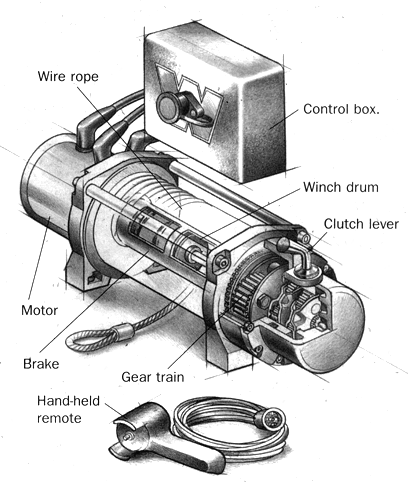
(A WARN brochure - reproduced without permission)
WARN
INDUSTRIES, INC.
12900 S. E. Capps Road,
Clackamas, OR USA 97015-8903
Customer Service:
1.800.543.9276
www.warn.com
THE WINCH - WHAT IS IT?
The basic concept:
A winch is a powerful gear
reduction device that converts electricity or some other energy source into pulling power.
Winch pulling capacities
can range as high as 15,000 lbs. and higher.
All winches must be
secured:
Commonly mounted to
vehicles, flatbed trailers and ATVs.
Can also be mounted to
many stable, stationary objects able to withstand the pulling forces.
There are a wide variety
of uses:
Popular uses include
vehicle self-recovery, loading and unloading of vehicles and equipment, pulling stumps or
brush and stretching wire fencing.
Winches are designed to
pull objects horizontally (not to lift, or hoist them).
If your application
requires lifting, you need a hoist (not a winch). Hoists are engineered specifically
for lifting.
A BASIC GUIDE TO CHOOSING THE
RIGHT WINCH FOR YOU
FIRST, YOU NEED TO ANSWER TWO
QUESTIONS:
WHAT DO I INTEND TO PULL, AND, HOW
MUCH WINCHING POWER DO I NEED?
There are many types of winches to
choose from, depending on your intended application
Fixed-mount vehicle
self-recovery winches.
Portable-mount vehicle
self-recovery winches.
Trailer winches.
Utility Winches
Fixed-mount ATV winches.
Portable-mount ATV
winches.
Consider your intended use or
application
Vehicle-mounted winches
are an excellent choice for vehicle self-recovery and other heavier uses. They
feature mechanical brake and hand-held remote control.
Trailer winches are
specially designed and engineered to efficiently pull rolling loads onto your trailer; or
unload them in a controlled manner. They feature a mechanical brake and a hand-held
remote control.
Utility winches are basic
pulling tools that can easily be mounted almost anywhere, such as within a barn, storage
or work area.
ATV winches are designed
to fit and work on an ATV, allowing you to create an even more versatile and capable
vehicle.
Consider the load you want to pull
Vehicle self-recovery
winches range in capacities from 3,500 lbs. to 15,000 lbs. A small vehicle in a
light recovery situation may only require the Warn Pull-Pak 3,500 lb. portable
winch. Your heavier full-size pick-up, buried up to its axles in mud, might require
all the pulling power of the Warn M15000, the strongest winch available.
Use the chart below for a basic weight formula when deciding on which vehicle
self-recovery winch is appropriate for your vehicle.
For a trailer winch used
for rolling loads, choose from the 2,500 and 3,500 lbs. capacity models. Don't let
this maximum rating confuse you when considering a rolling load. The Z3500 trailer
winch is capable of pulling an 11,900 lb. rolling load up a 20% grade.
Use the chart below to help you determine the winch pulling capacity needed.
Utility winches range in
capacity from 1,000 to 4,000 lbs. Use either chart to help you determine the
appropriate capacity, depending on your anticipated use.
ATV winches are available
in 2,000 and 2,500 lbs. capacities. Use the self-recovery formula to help choose the
appropriate winch.
CALCULATE THE
CAPACITY YOU NEED FOR A SELF-RECOVERY WINCH:
Take the gross weight of the
vehicle* and multiply by 1.5 - this is the minimum size winch for the vehicle.
* Note: Gross weight
of vehicle is located on the driver's door, on the inside panel. Remember to add any
cargo, camper shells, or other items your vehicle may be carrying.
|
| CALCULATE THE CAPACITY YOU NEED
FOR A TRAILER WINCH: |
|
1. Determine the % of grade you will be
rolling the load up. This is done by dividing the amount of the rise of the ramp by
the length of the ramp. Example of 10% grade: |
2. Use the chart and find the
column that matches your slope and run down until you find the weight of your car or the
next higher number. Next go left on the chart to find the best winch suited for your
application. |
| Use the chart to determine the winch
best suited for your rolling load application. |

|
| Winch |
10%
[3°] |
20%
[6°] |
30%
[11°] |
50%
[17°] |
70%
[35°] |
100%
[45°] |
| 1000 lb. |
5000 lb. |
3400 lb. |
2600 lb. |
1900 lb. |
1500 lb. |
1300 lb. |
| 2000 lb. |
10000 lb. |
6800 lb. |
5200 lb. |
3800 lb. |
3000 lb. |
2600 lb. |
| 2500 lb. |
12500 lb. |
8500 lb. |
6500 lb. |
4750 lb. |
3750 lb. |
3250 lb. |
| 3500 lb. |
17500 lb. |
11900 lb. |
9100 lb. |
6650 lb. |
5250 lb. |
4550 lb. |
|
|
3. This is
only a guide and based on the average rolling load of a vehicle. Some applications
may require a larger winch than the chart calls out. |
|
SOME KEY FEATURES TO CONSIDER:
Types of motors
Series Wound™ motors
are designed for extended duty cycles and high performance under heavy loads. All
the Warn Vehicle Self-Recovery winches feature this advanced design.
Permanent magnet motors
provide reliable performance in the under 4000 lb. class.
Gear Train
The gear train is what
translates motor energy into powerful pulling power.
Most Warn winches feature
the planetary gear drive train system, proven the most reliable, efficient and durable
design under the worst conditions in the world.
Planetary gears are more
efficient than other gear designs, reducing amperage draw as well as providing faster line
speeds.
Fairlead
When using the winch at an
angle, the fairlead (or wire lead) acts to guide the wire rope on to the spooling drum.
There are two types:
roller or hawse. A roller fairlead helps to reduce wire rope wear, especially on
pulls at severe angles. A hawse is very simple, basic design.
Types of controls
All Warn self-recovery and
trailer winches include a hand-held remote control, which allows operation at a distance
from the winch.
Utility winches are
operated with a manual, motor-mounted control switch.
Warn ATV winches
vary. The A2000 utilizes a manual, remote mounted control. The A2500 features
a hand-held remote control.
Take the gross weight
of the vehicle* and multiply by 1.5 - this is the minimum size winch for the vehicle.
| Winch Model |
Capacity
(lbs.) |
Intended type
of application |
Mounting
Type |
Type of
motor |
Type of
gear train |
Brake |
Fairlead |
Type of
control |
| M15000 |
15,000 |
Vehicle self-recovery |
Fixed |
Series Wound™ |
Planetary |
Yes |
Roller |
Remote |
| M12000 |
12,000 |
Vehicle self-recovery |
Fixed |
Series Wound™ |
Planetary |
Yes |
Roller |
Remote |
| HS9500 |
9,500 |
Vehicle self-recovery |
Fixed |
Series Wound™ |
Planetary |
Yes |
Roller |
Remote |
| HS9500i |
9,500 |
Vehicle self-recovery |
Fixed |
Series Wound™ |
Planetary |
Yes |
Roller |
Remote |
| XD9000i |
9,000 |
Vehicle self-recovery |
Fixed |
Series Wound™ |
Planetary |
Yes |
Roller |
Remote |
| XD9000i Multi-Mount |
9,000 |
Vehicle self-recovery |
Portable |
Series Wound™ |
Planetary |
Yes |
Roller |
Remote |
| M8274-50 |
8,000 |
Vehicle self-recovery |
Fixed |
Series Wound™ |
Spur |
Yes |
Roller |
Remote |
| M8000 |
8,000 |
Vehicle self-recovery |
Fixed |
Series Wound™ |
Planetary |
Yes |
Roller or Hawse |
Remote |
| X8000i |
8,000 |
Vehicle self-recovery |
Fixed |
Series Wound™ |
Planetary |
Yes |
Roller |
Remote |
| X8000i Multi-Mount |
8,000 |
Vehicle self-recovery |
Portable |
Series Wound™ |
Planetary |
Yes |
Hawse |
Remote |
| M6000 |
6,000 |
Vehicle self-recovery |
Fixed |
Series Wound™ |
Planetary |
Yes |
Roller |
Remote |
| M6000-SDP |
6,000 |
Vehicle self-recovery |
Portable |
Series Wound™ |
Planetary |
Yes |
Roller |
Remote |
| Pull-Pak |
3,500 |
Vehicle self-recovery |
Portable |
Permanent Magnet |
Planetary |
Yes |
Roller |
Remote |
| Z3500 |
3,500 |
Trailer |
Fixed |
Permanent Magnet |
Planetary |
Yes |
Roller |
Remote |
| T2500 |
2,500 |
Trailer |
Fixed |
Permanent Magnet |
Planetary |
Yes |
Roller |
Remote |
| UW1000 |
1,000 |
Utility |
Fixed |
Permanent Magnet |
Split Ring |
Yes |
No |
Manual |
| P2500 |
2,500 |
Utility |
Fixed |
Permanent Magnet |
Planetary |
Optional |
Hawse |
Manual |
| U2500 |
2,500 |
Utility |
Portable |
Permanent Magnet |
Planetary |
Optional |
Hawse |
Manual |
| A2000 |
2,000 |
ATV |
Fixed |
Permanent Magnet |
Planetary |
Optional |
Hawse |
Manual |
| A2500 |
2,500 |
ATV |
Portable |
Permanent Magnet |
Planetary |
Optional |
Roller |
Remote |
| A2500 Multi-Mount |
2,500 |
ATV |
Portable |
Permanent Magnet |
Planetary |
Optional |
Roller |
Remote |
AVAILABILITY OF MOUNTING SYSTEMS
When choosing a winch you should
consider the availability of a proper mounting system
Fixed winch mounts are
available for most popular trucks, SUVs and ATV applications. Check with your sales
associate for specific listings.
Portable winches for
trucks and SUVs are designed to fit on any standard 2" Class III receiver
hitch. Warn front receivers are available for most popular vehicle makes.
ATV Portable winches are
designed to fit on any standard 1" Class II receiver hitch. Warn offers a kit
that includes both front and rear receivers. Available for many popular ATV models.
Trailer and utility
winches include a universal flatbed mounting plate and hardware for mounting the winch
directly to the trailer.
Universal flatbed mounting
plates for most of the vehicle self-recovery winches are available.
HOW IT WORKS
A DC electric-powered winch provides
reliable service for intermittent utility and recreational use - assuming, or course, that
sufficient battery power is available.
The winch motor is powered
by a 12-volt battery source. The motor provides power to the gear mechanism, which
turns the winch drum and winds the wire rope.
The reduction gear
converts winch motor power into a large pulling force.
Many winches have a
braking system. The brake is automatically applied when the winch motor is stopped
and there is load on the rope. The brake prevents the winch drum from turning, which
then holds the object being winched in place.
Many winches also include
a clutch, which allows the operator to manually disengage the spooling drum from the gear
train, enabling the drum to rotate freely (known as "freespooling").
Engaging the clutch locks the winch drum back into the gear train.
Winches without a clutch for free-spooling use power to pull the load in or pull the wire
rope off the drum.
The control mechanism
(remote or manual) allows the operator to change the direction of the winch drum rotation,
in or out.
WINCHING ACCESSORIES
Alone, the winch is not
much more than a simple tool. But when used with certain accessories and
enhancements, your Warn winch can become a versatile and productive tool. Some are
vital to the safe operation of your winch, while others offer added versatility and
convenience.
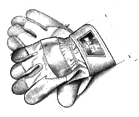
|
GLOVES. It is extremely
important to wear protective gloves while operating the winch or handling the wire
rope. Avoid loose fitting clothes or anything that could become entangled in the
wire rope and other moving parts. |
SNATCH BLOCK.
Used properly, the multi-purpose snatch block allows you to: (1) increase your winches
pulling power; and (2) change your pulling direction without damaging the wire rope. |
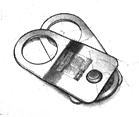
|
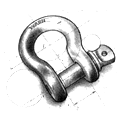
|
CLEVIS/SHACKLES. The
shackle is a safe means for connecting the looped ends of cables, straps and snatch
blocks. The shackle's pin is threaded to allow easy removal. |
TREE TRUNK PROTECTOR.
Typically made of tough, high-quality nylon, the recovery strap enables the operator to
secure the winch rope to a wider variety of anchor points and objects. |
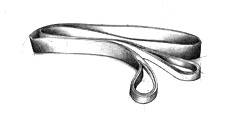
|
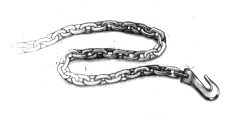
|
CHOKER CHAIN. Can be used
to hook up to another vehicle or sharp object for an anchor point. |
TOW HOOKS.
Secured properly to your vehicle's frame, tow hooks provide an attachment point for wire
hooks, straps, and chains. |
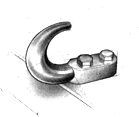
|
SAFETY CONSIDERATIONS
A winch is a powerful tool,
so extreme care should be exercised when operating one.
Read and understand the
safety precautions and operating instructions contained in the owners manual before
installing and operating a winch.
Never use a winch for
applications it was not designed for, such as lifting an object or moving people.
Always keep hands clear of
wire rope and fairlead opening during operation and spooling.
Careless winch operation
can result in serious injury or property damage.
© 2001 Warn Industries,
Inc. all rights reserved. PN 915351.BO 8MSL
WARN
Return to Winch Install | Jeep Specs
Shop for
Jeep Toys and Books | See the
Toy Jeeps | Off-Road Index
Photos and text
(except as noted), Layout and Design © 2003 Paul
M. Provencher All Rights Reserved.
Contents of this Web Site may not be used without written permission
 Visitors since 3/3/03 Visitors since 3/3/03
Home
|








